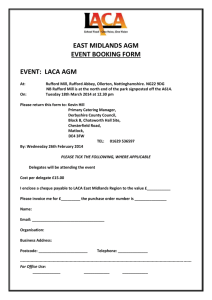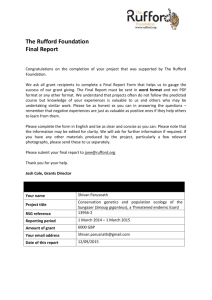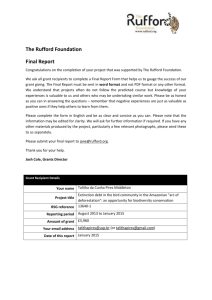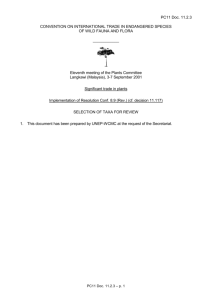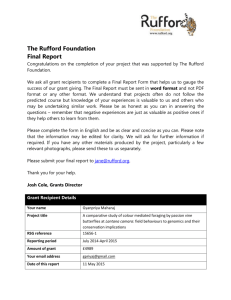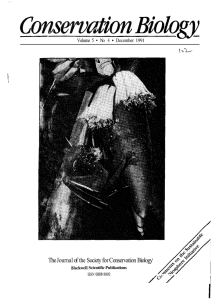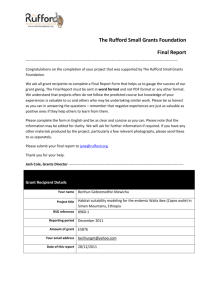Final Report - The Rufford Foundation
advertisement
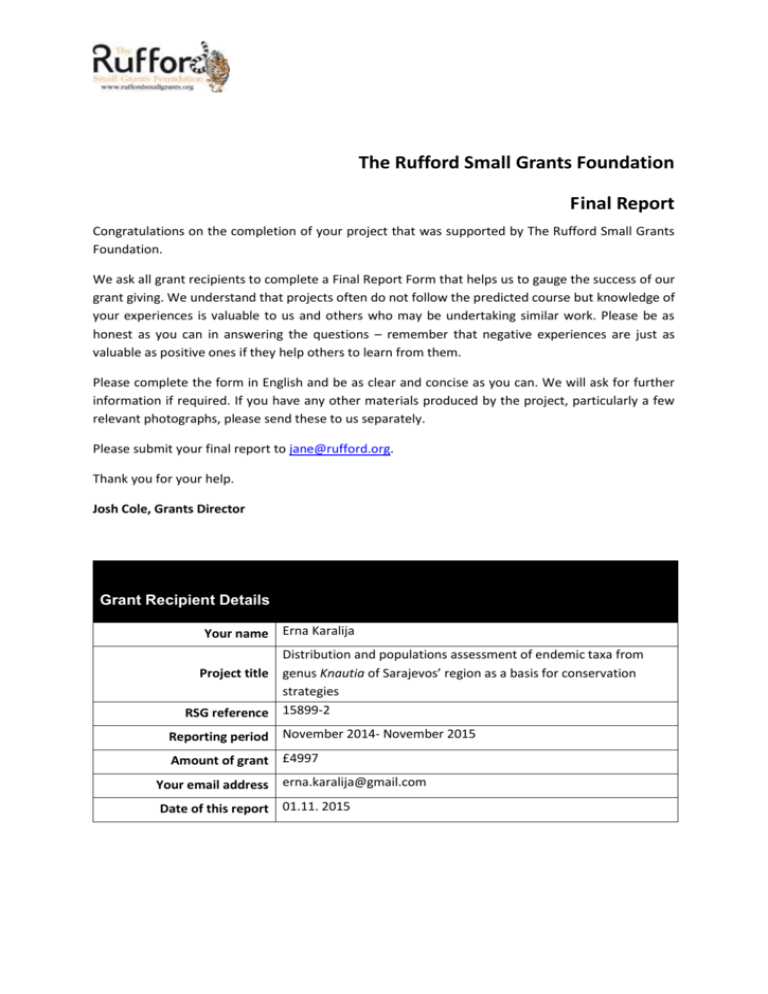
The Rufford Small Grants Foundation Final Report Congratulations on the completion of your project that was supported by The Rufford Small Grants Foundation. We ask all grant recipients to complete a Final Report Form that helps us to gauge the success of our grant giving. We understand that projects often do not follow the predicted course but knowledge of your experiences is valuable to us and others who may be undertaking similar work. Please be as honest as you can in answering the questions – remember that negative experiences are just as valuable as positive ones if they help others to learn from them. Please complete the form in English and be as clear and concise as you can. We will ask for further information if required. If you have any other materials produced by the project, particularly a few relevant photographs, please send these to us separately. Please submit your final report to jane@rufford.org. Thank you for your help. Josh Cole, Grants Director Grant Recipient Details Your name Erna Karalija Distribution and populations assessment of endemic taxa from Project title genus Knautia of Sarajevos’ region as a basis for conservation strategies RSG reference 15899-2 Reporting period November 2014- November 2015 Amount of grant £4997 Your email address erna.karalija@gmail.com Date of this report 01.11. 2015 1. Please indicate the level of achievement of the project’s original objectives and include any relevant comments on factors affecting this. Objective Field research Plant collection Not achieved Partially achieved Fully achieved x x Data collection x Capacity building and education x Conservation activities x Social media promotion x Comments All planned field trips were conducted according to the plan. Some of the localities were under drought stress and plants were not collected. GIS mapping and GPS coordinates were recorded, maps were made and were compared to the literature data was made. Several field investigation was conducted with students, collaboration with NGO Bio.Log was established. In collaboration with students (seeds were collected for the seed bank), Knautia population assessment. Promotion through twitter, Instagram and Facebook group Contest for the best photo in collaboration with Faculty of Forestry and NGO Bio.Log. 2. Please explain any unforeseen difficulties that arose during the project and how these were tackled (if relevant). During field investigation on some localities around Sarajevo due to the drought, plants were dried out, or with sunburns and it was not possible to correctly assess the population dynamics or properly identify plants. 3. Briefly describe the three most important outcomes of your project. 1. General assessment of population status of Knautia species regarding endangerment level and population distribution. 2. Social promotion induced large interest in students and stimulated their enrolment in seed collecting through field investigations. 3. Through best photo contents for Fascination of Plants day students were stimulated to apply best photo for the contest, and they conducted field research on their own. 4. Briefly describe the involvement of local communities and how they have benefitted from the project (if relevant). Bio.Log was the NGO who largely participated in conduction of this research, and they also promoted conservation of Knautia species through their other activities. During their activities with children (15 years old) their promoted also conservation of endangered species and educated children not to destroy natural populations. Students of Faculty of Science and Faculty of Forestry had the opportunity to conduct parts of the field studies on their own and to learn how to plan the field study as well how to recognize anthropogenic influences on plant populations. Collaborative workshop with NGOs was also conducted and included Bio.Log and DSB, a large portion of students included in workshop showed interest in continuation of their field research and to choose their undergraduate and postgraduate thesis form this area. 5. Are there any plans to continue this work? We plan to continue our work by collaboration with Protected Areas of Sarajevo Canton (government organisation) and to define important habitats and inform the public through information billboards within protected areas. 6. How do you plan to share the results of your work with others? All results are available on Facebook, and are shared with NGOs as well as GO (Protected Areas of Sarajevo Canton). 7. Timescale: Over what period was the RSG used? How does this compare to the anticipated or actual length of the project? Planed timescale: 1. January –April, 2015 – literature analysis, GIS distribution maps for investigated taxa. 2. May-September, 2015: Field trips with students for botanical surveys and seed collecting and for population status assessment (three field trips per month). 3. October, 2015: Collaborative workshop with NGOs representatives for determination of priority taxa for conservations. 4. November, 2015: Report preparation for government institutions dealing with conservation of plant life with proposal of priority Knautia taxa for conservation plan, and a detailed List of Knautia taxa for future Red Book of B&H. 5. December, 2015: results summary, access data base preparation final report preparation. Project actually lasted until November 2015 due to large interest of students and due to partially conducted field studies by students alone, field research was finished earlier and it was possible to shorten the period of field research. 8. Budget: Please provide a breakdown of budgeted versus actual expenditure and the reasons for any differences. All figures should be in £ sterling, indicating the local exchange rate used. Item Accommodation and food for field research Botanical supplies 200 Design and printing of brochures 1000 Actual Difference Comments Amount 2100 350 Difference was covered by participants of the project 395 150 Difference was covered by participants of the project 300 100 Difference was covered by participants of the project 1000 0 Comunication and postage costs 0 100 100 Data base preparation 0 300 300 Laptop and printer 1120 1500 380 Software 500 600 100 TOTAL 4997 6577 1580 Fuel expenses Budgeted Amount 1750 200 Difference was covered by participants of the project Difference was covered by participants of the project Difference was covered by participants of the project Difference was covered by participants of the project Difference was covered by participants of the project 9. Looking ahead, what do you feel are the important next steps? Collaboration with GO, since the laws and their implementation is directly dependent upon GO. 10. Did you use the RSGF logo in any materials produced in relation to this project? Did the RSGF receive any publicity during the course of your work? Yes, brochures, pamphlets were distributed, and are also available through Twitter and Facebook promotion, as well as through Bio.log web page. Also competition for best plant photo was organised for students. Results of this research were presented at ICOEST congress as oral presentation (accepted abstracts for the congress - http://www.icoest2015.com/abstracts), and also results are going to be presented on the first Balkan Rufford Small Grant Congress. 11. Any other comments? It was a pleasure to conduct this research mainly because a large interest of students in the research matter. Due to limited founds not all students were able to accompany us in the field but never the less they were more than happy to participate in material herbarisation, and lab work. Plant material gathered in the field was transported in Czech Republic for UPLC analysis for possible easier classification of closely related genera. The date gave us some insight in biochemical composition of different Knautia plant parts as well as different species. The research article is in preparation for publication. Also Database is started and is still designed as internal database for Laboratory for research and protection of endemic genofond, but I the future we plan to make the database available for public.

